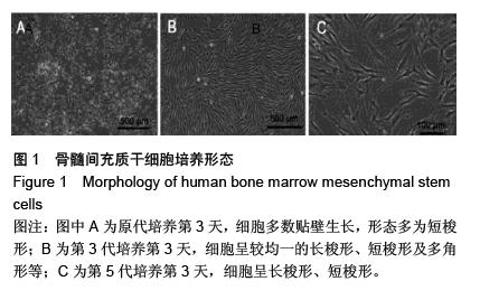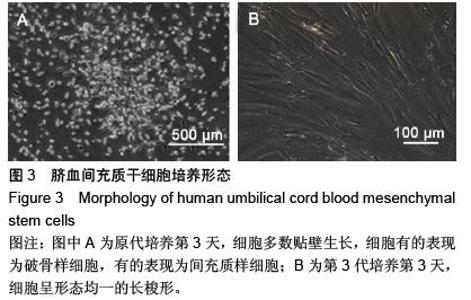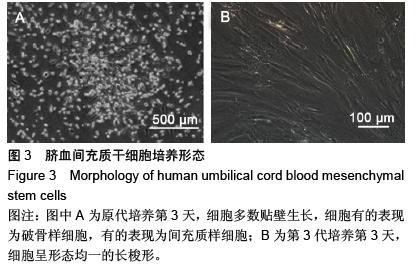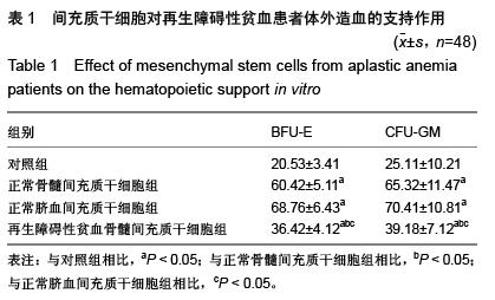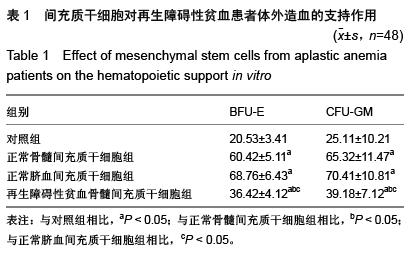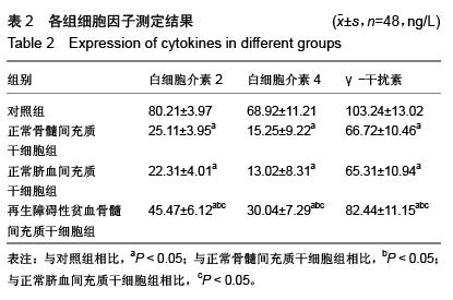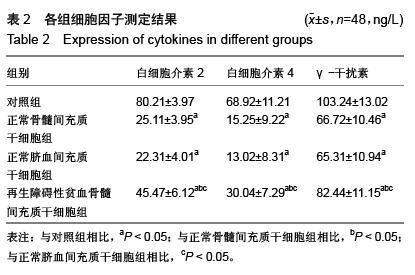Chinese Journal of Tissue Engineering Research ›› 2016, Vol. 20 ›› Issue (1): 107-112.doi: 10.3969/j.issn.2095-4344.2016.01.019
Previous Articles Next Articles
Effects of mesenchymal stem cells on hematopoietic support and secretory function of T lymphocytes in patients with aplastic anemia
Li Gang-can, Song Yan-ping, Zhang Yun-jie, Li Guang, Wang Hao, Xie Jia
- Xi’an Institute of Hematology, Xi'an Central Hospital, Xi’an 710003, Shaanxi Province, China
-
Received:2015-11-30Online:2016-01-01Published:2016-01-01 -
Contact:Xie Jia, Master, Associate chief physician, Xi’an Institute of Hematology, Xi’an Central Hospital, Xi’an 710003, Shaanxi Province, China -
About author:Li Gang-can, Master, Chief physician, Xi’an Institute of Hematology, Xi’an Central Hospital, Xi’an 710003, Shaanxi Province, China -
Supported by:the Science and Technology Plan of Xi’an, No. SF1021(2)
CLC Number:
Cite this article
Li Gang-can, Song Yan-ping, Zhang Yun-jie, Li Guang, Wang Hao, Xie Jia. Effects of mesenchymal stem cells on hematopoietic support and secretory function of T lymphocytes in patients with aplastic anemia[J]. Chinese Journal of Tissue Engineering Research, 2016, 20(1): 107-112.
share this article
| [1] 刘海芸,刘婷婷.再生障碍性贫血发病机制研究进展[J].中国实验血液学杂志,2015,23(4): 1216-1220.[2] Zeng Y, Katsanis E.The complex pathophysiology of acquired aplastic anaemia. Clin Exp Immunol. 2015;180(3): 361-370.[3] Young NS. Current concepts in the pathophysiology and treatment of aplastic anemia. Hematology Am Soc Hematol Educ Program. 2013;2013:76-81. [4] Fajardo-Orduña GR, Mayani H, Montesinos JJ. Hematopoietic Support Capacity of Mesenchymal Stem Cells: Biology and Clinical Potential. Arch Med Res. 2015 Oct 29. [Epub ahead of print][5] Sahraneshin Samani F, Ebrahimi M, Zandieh T, et al. In Vitro Differentiation of Human Umbilical Cord Blood CD133(+)Cells into Insulin Producing Cells in Co-Culture with Rat Pancreatic Mesenchymal Stem Cells. Cell J. 2015;17(2):211-220.[6] Larijani B, Aghayan HR, Goodarzi P, et al. GMP-grade human fetal liver-derived mesenchymal stem cells for clinical transplantation. Methods Mol Biol. 2015;1283:123-136.[7] Yin T, He S, Su C, et al. Genetically modified human placenta?derived mesenchymal stem cells with FGF?2 and PDGF?BB enhance neovascularization in a model of hindlimb ischemia. Mol Med Rep. 2015;12(4):5093-5099.[8] 李启明,程天民,李宁,等.脐血间充质干细胞分离, 培养与鉴定[J].重庆医学,2005,34(6): 879-881.[9] Liao L, Zhao RC. Mesenchymal Stem Cells and Their Immunomodulatory Properties. In: Stem Cells: Basics and Clinical Translation. Springer, 2015:67-83.[10] van den Berk LC, Jansen BJ, Snowden S, et al. Cord blood mesenchymal stem cells suppress DC-T Cell proliferation via prostaglandin B2. Stem Cells Dev. 2014;23(14):1582-1593.[11] Lee HJ, Ko JH, Ko AY, et al. Intravenous infusion of mesenchymal stem/stromal cells decreased CCR7(+) antigen presenting cells in mice with corneal allotransplantation. Curr Eye Res. 2014;39(8):780-789.[12] Plock JA, Schnider JT, Zhang W, et al. Adipose- and Bone Marrow-Derived Mesenchymal Stem Cells Prolong Graft Survival in Vascularized Composite Allotransplantation. Transplantation. 2015;99(9):1765-1773.[13] Wu Y, Cao Y, Li X, et al. Cotransplantation of haploidentical hematopoietic and umbilical cord mesenchymal stem cells for severe aplastic anemia: successful engraftment and mild GVHD. Stem Cell Res. 2014;12(1):132-138.[14] 张之南, 沈悌.血液病诊断及疗效标准[M].北京:科学出版社, 2007.[15] Qin X, Baumann I, Chen J, et al. Refractory cytopenia of children and acquired aplastic anemia: a clinical and pathological study of 130 cases. Zhonghua Xue Ye Xue Za Zhi. 2014;35(8):713-718.[16] Dolberg OJ, Levy Y. Idiopathic aplastic anemia: diagnosis and classification. Autoimmun Rev. 2014;13(4-5):569-573.[17] Qian D, Gong J, He Z, et al. Bone Marrow-Derived Mesenchymal Stem Cells Repair Necrotic Pancreatic Tissue and Promote Angiogenesis by Secreting Cellular Growth Factors Involved in the SDF-1 α /CXCR4 Axis in Rats. Stem Cells Int. 2015;2015:306836.[18] Luan Y, Ding W, Ju ZY, et al. Bone marrow-derived mesenchymal stem cells protect against lung injury in a mouse model of bronchopulmonary dysplasia. Mol Med Rep. 2015;11(3):1945-1950.[19] Zhu F, Wang J, Qiu X, et al. Smoke inhalation injury repaired by a bone marrow-derived mesenchymal stem cell paracrine mechanism: Angiogenesis involving the Notch signaling pathway. J Trauma Acute Care Surg. 2015;78(3):565-572.[20] 唐旭东,张姗姗,许勇钢, 等.T 细胞亚群在重型再生障碍性贫血治疗中的疗效预测价值[J].中医杂志,2013,54(20): 1755-1758.[21] 郭鹏,刘传方,赵雯.人脐带沃顿胶间充质干细胞对重型再生障碍性贫血调节性T细胞及Foxp3基因的影响[J].山东大学学报:医学版,2011,49(9): 71-76.[22] Wu Q, Zhang J, Shi J, et al. Increased bone marrow (BM) plasma level of soluble CD30 and correlations with BM plasma level of interferon (IFN)-γ, CD4/CD8 T-cell ratio and disease severity in aplastic anemia. PLoS One. 2014;9(11): e110787.[23] 蒋白丽,李建平,李文倩,等. CD8+T细胞及其分泌的细胞因子在再生障碍性贫血发病机制中的作用[J].中国实验血液学杂志, 2014, 22(2): 569-572.[24] 张婧瑶,许洪志,尹冬梅,等.再生障碍性贫血、骨髓增生异常综合征、急性髓系白血病患者CD8+T细胞亚群的变化及临床意义[J].中国实验血液学杂志,2013,21(1): 203-208.[25] Desalphine M, Bagga PK, Gupta PK, et al. To evaluate the role of bone marrow aspiration and bone marrow biopsy in pancytopenia. J Clin Diagn Res. 2014;8(11):FC11-15.[26] Desmond R, Townsley DM, Dunbar C, et al. Eltrombopag in aplastic anemia.Semin Hematol. 2015;52(1):31-37.[27] 向永胜,王龙.环孢素A对慢性再生障碍性贫血患者血清γ干扰素及一氧化氮、一氧化氮合酶的影响[J].中国动脉硬化杂志, 2011, 19(3):220-222. |
| [1] | Jiang Tao, Ma Lei, Li Zhiqiang, Shou Xi, Duan Mingjun, Wu Shuo, Ma Chuang, Wei Qin. Platelet-derived growth factor BB induces bone marrow mesenchymal stem cells to differentiate into vascular endothelial cells [J]. Chinese Journal of Tissue Engineering Research, 2021, 25(25): 3937-3942. |
| [2] | Chen Yang, Huang Denggao, Gao Yuanhui, Wang Shunlan, Cao Hui, Zheng Linlin, He Haowei, Luo Siqin, Xiao Jingchuan, Zhang Yingai, Zhang Shufang. Low-intensity pulsed ultrasound promotes the proliferation and adhesion of human adipose-derived mesenchymal stem cells [J]. Chinese Journal of Tissue Engineering Research, 2021, 25(25): 3949-3955. |
| [3] | Zhang Lishu, Liu Anqi, He Xiaoning, Jin Yan, Li Bei, Jin Fang. Alpl gene affects the therapeutic effect of bone marrow mesenchymal stem cells on ulcerative colitis [J]. Chinese Journal of Tissue Engineering Research, 2021, 25(25): 3970-3975. |
| [4] | Ruan Guangping, Yao Xiang, Liu-Gao Miyang, Cai Xuemin, Li Zian, Pang Rongqing, Wang Jinxiang, Pan Xinghua. Umbilical cord mesenchymal stem cell transplantation for traumatic systemic inflammatory response syndrome in tree shrews [J]. Chinese Journal of Tissue Engineering Research, 2021, 25(25): 3994-4000. |
| [5] | Mo Jianling, He Shaoru, Feng Bowen, Jian Minqiao, Zhang Xiaohui, Liu Caisheng, Liang Yijing, Liu Yumei, Chen Liang, Zhou Haiyu, Liu Yanhui. Forming prevascularized cell sheets and the expression of angiogenesis-related factors [J]. Chinese Journal of Tissue Engineering Research, 2021, 25(22): 3479-3486. |
| [6] | Chen Lei, Zheng Rui, Jie Yongsheng, Qi Hui, Sun Lei, Shu Xiong. In vitro evaluation of adipose-derived stromal vascular fraction combined with osteochondral integrated scaffold [J]. Chinese Journal of Tissue Engineering Research, 2021, 25(22): 3487-3492. |
| [7] | Wei Qin, Zhang Xue, Ma Lei, Li Zhiqiang, Shou Xi, Duan Mingjun, Wu Shuo, Jia Qiyu, Ma Chuang. Platelet-derived growth factor-BB induces the differentiation of rat bone marrow mesenchymal stem cells into osteoblasts [J]. Chinese Journal of Tissue Engineering Research, 2021, 25(19): 2953-2957. |
| [8] | Chen Xiao, Guo Zhi, Chen Lina, Liu Xuanyong, Zhang Yihuizhi, Li Xumian, Wang Yueqiao, Wei Liya, Xie Jing, Lin Li. Factors affecting the mobilization and collection of autologous peripheral blood hematopoietic stem cells [J]. Chinese Journal of Tissue Engineering Research, 2021, 25(19): 2958-2962. |
| [9] | Guo Zhibin, Wu Chunfang, Liu Zihong, Zhang Yuying, Chi Bojing, Wang Bao, Ma Chao, Zhang Guobin, Tian Faming. Simvastatin stimulates osteogenic differentiation of bone marrow mesenchymal stem cells [J]. Chinese Journal of Tissue Engineering Research, 2021, 25(19): 2963-2968. |
| [10] | Li Congcong, Yao Nan, Huang Dane, Song Min, Peng Sha, Li Anan, Lu Chao, Liu Wengang. Identification and chondrogenic differentiation of human infrapatellar fat pad derived stem cells [J]. Chinese Journal of Tissue Engineering Research, 2021, 25(19): 2976-2981. |
| [11] | Gao Yuanhui, Xiang Yang, Cao Hui, Wang Shunlan, Zheng Linlin, He Haowei, Zhang Yingai, Zhang Shufang, Huang Denggao. Comparison of biological characteristics of adipose derived mesenchymal stem cells in Wuzhishan inbreed miniature pigs aged two different months [J]. Chinese Journal of Tissue Engineering Research, 2021, 25(19): 2988-2993. |
| [12] | Cao Yang, Zhang Junping, Peng Li, Ding Yi, Li Guanghui. Isolation and culture of rabbit aortic endothelial cells and biological characteristics [J]. Chinese Journal of Tissue Engineering Research, 2021, 25(19): 3000-3003. |
| [13] | Dai Min, Wang Shuai, Zhang Nini, Huang Guilin, Yu Limei, Hu Xiaohua, Yi Jie, Yao Li, Zhang Ligang. Biological characteristics of hypoxic preconditioned human amniotic mesenchymal stem cells [J]. Chinese Journal of Tissue Engineering Research, 2021, 25(19): 3004-3008. |
| [14] | Qin Yanchun, Rong Zhen, Jiang Ruiyuan, Fu Bin, Hong Xiaohua, Mo Chunmei. Chinese medicine compound preparation inhibits proliferation of CD133+ liver cancer stem cells and the expression of stemness transcription factors [J]. Chinese Journal of Tissue Engineering Research, 2021, 25(19): 3016-3023. |
| [15] | Dai Yaling, Chen Lewen, He Xiaojun, Lin Huawei, Jia Weiwei, Chen Lidian, Tao Jing, Liu Weilin. Construction of miR-146b overexpression lentiviral vector and the effect on the proliferation of hippocampal neural stem cells [J]. Chinese Journal of Tissue Engineering Research, 2021, 25(19): 3024-3030. |
| Viewed | ||||||
|
Full text |
|
|||||
|
Abstract |
|
|||||
